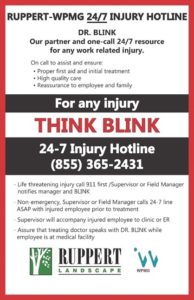By Dave Sanders
 When an on-the-job injury occurs, the priority is making sure that our injured employee receives the best possible care. If an injury is life-threatening, dialing 911 is the best option for quick and qualified care. But if an injury isn’t a life-threatening emergency, the company has enlisted a resource to help evaluate what happened and prioritize the best possible care. For six years, we have been partnering with Dr. Robert Blink and Worksite Partners Medical Group to be our on-call 24/7 resource for any work-related injury. This service helps to ensure we take the correct steps for our people.
When an on-the-job injury occurs, the priority is making sure that our injured employee receives the best possible care. If an injury is life-threatening, dialing 911 is the best option for quick and qualified care. But if an injury isn’t a life-threatening emergency, the company has enlisted a resource to help evaluate what happened and prioritize the best possible care. For six years, we have been partnering with Dr. Robert Blink and Worksite Partners Medical Group to be our on-call 24/7 resource for any work-related injury. This service helps to ensure we take the correct steps for our people.
What’s the process?
 When any injury occurs, and before going for any treatment (unless 911 is called), our supervisor, with the injured worker present, calls the 24/7 INJURY HOTLINE (855) 365-AID-1 or (855) 365-2431. They will speak first with an operator who will take down demographic information, will get some of the initial details about what happened and why the caller needs medical attention (after first ruling out that it’s not necessary to call 911) The operator then puts the person on hold briefly and contacts Dr. Blink so that he is then connected with the supervisor and the employee who is on hold. Dr. Blink then speaks directly with the employee about what happened, how he/she is feeling, and they work together to determine what the next steps should be.
When any injury occurs, and before going for any treatment (unless 911 is called), our supervisor, with the injured worker present, calls the 24/7 INJURY HOTLINE (855) 365-AID-1 or (855) 365-2431. They will speak first with an operator who will take down demographic information, will get some of the initial details about what happened and why the caller needs medical attention (after first ruling out that it’s not necessary to call 911) The operator then puts the person on hold briefly and contacts Dr. Blink so that he is then connected with the supervisor and the employee who is on hold. Dr. Blink then speaks directly with the employee about what happened, how he/she is feeling, and they work together to determine what the next steps should be.
“Our role is to offer assistance to people on site as to how can we help access the most appropriate level of medical care,” said Dr. Robert Blink. “We are not providing medical advice over the phone; we are providing a resource to the caller so that he or she can figure out how best to approach the situation.”
By having a confidential conversation with an employee right after an injury occurs (he is bilingual, speaking both English and Spanish) Dr. Blink can help determine what next steps are best to ensure the appropriate care. That next step can range from proceed to the closest emergency room or urgent care center, to make an appointment with a family doctor or specialist, to handle it with self-care by administering first aid treatment without seeing a medical professional. All of these are viable options, depending on the issue, and the decision is made by the employee as to what he or she thinks is the best course of action.
If the conversation leads an employee to go to seek medical attention at an ER, urgent care, or doctor’s office, Dr. Blink then asks to have the treating physician call him (Dr. Blink) directly while the patient is there so that the two doctors can have a conversation. This additional conversation between medical professionals enables a more efficient conveying of information about what happened and what next steps are appropriate. “Sometimes this conversation is difficult to arrange, but this is often tremendously helpful in terms of next steps,” said Dr. Blink.
What are the benefits?
This is a resource for employees who have had an injury or may just have a medical question. It will provide an employee with access to someone—on the spot if/when something occurs—who can help with a decision as to what the best and most convenient treatment should be. In many instances, it can prevent unnecessary visits to the emergency room and can help guide an employee to the best possible care choice. Hopefully, this is not the first time you’ve heard about Dr. Blink and this resource. However, if it is, please familiarize yourself with this process so that if you ever need to use this service, you know what to expect.
If you have an injury on the job that does not involve 911, the manager should call the 24/7 INJURY HOTLINE number immediately so that he can become a partner in the process, helping you make decisions about your next steps that are efficient, effective and provide you with the best possible medical care.